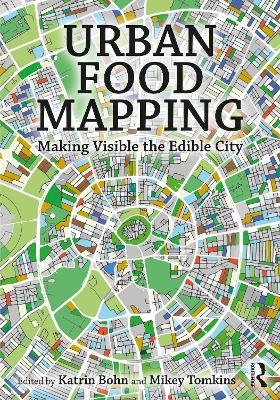
Urban Food Mapping
Routledge (Verlag)
978-1-032-40280-2 (ISBN)
- Titel z.Zt. nicht lieferbar
- Versandkostenfrei innerhalb Deutschlands
- Auch auf Rechnung
- Verfügbarkeit in der Filiale vor Ort prüfen
- Artikel merken
Richly explored, using over 200 mapping images in 25 selected chapters, this book identifies urban food mapping as a distinct activity and area of research that enables a more nuanced way of understanding the multiple issues facing contemporary urbanism and the manyfold roles food spaces play within it. The authors of this multidisciplinary volume extend their approaches to place making, storytelling, in-depth observation and imagining liveable futures and engagement around food systems, thereby providing a comprehensive picture of our daily food flows and intrastructures. Their images and essays combine theoretical, methodological and practical analysis and applications to examine food through innovative map-making that empowers communities and inspires food planning authorities. This first book to systematise urban food mapping showcases and bridges disciplinary boundaries to make theoretical concepts as well as practical experiences and issues accessible and attractive to a wide audience, from the activist to the academic, the professional and the amateur. It will be of interest to those involved in the all-important work around food cultures, food security, urban agriculture, land rights, environmental planning and design who wish to create a more beautiful, equitable and sustainable urban environment.
Katrin Bohn is an architect and urban practitioner and a principal lecturer at the University of Brighton, UK. Together with André Viljoen, she forms Bohn&Viljoen Architects, developing their food-focused urban design concept Continuous Productive Urban Landscapes (CPUL) in theory and practice. Mikey Tomkins is an independent researcher, artist and honorary research fellow at the University of Brighton, UK. He runs Edible Urban, a company that conducts the Edible Mapping Project, a participatory mapping project engaging communities in revisioning urban space for food production.
Part 1: FOOD GROWING SITES: Reimagining land use Edible London: A greater London Agriculture Agroecologics: Reimagining an agri-urban design for Luxembourg Re-negotiating the boundaries between infrastructure and landscape: Mapping infrastructural ecologies Mapping urban agriculture potentials in Nerima City, Tokyo Mapping multifunctional agro-urban landscape to manage the edible city in North-Eastern Italy Part 2: FOOD SYSTEM ACTIVITIES: Recording economies, patterns and crises Using visual methods to map green infrastructure for a sustainable food economy in Letchworth Garden City A participatory digital mapping practice: Proposing Integrated Development Areas for food secure systems in cities Walking out for dinner: Discovering and mapping food choices in Saigon Follow the food… and the spaces it shapes Rupturing the mundane in times of crisis: New geographies of food in Hannover, Germany Part 3: FOOD STAKEHOLDERS: Proposing change for communities Lambeth plots: Two mapping projects highlighting existing and potential city spaces for food growing The practice of sharing: Mapping food networks in Delft, South Africa Six feet high and rising: Mapping the Edible City as a theatre of food Mapping seeds of freedom with Red de Huerteros Medellín Food in urban design and planning: The CPUL Opportunity Mapping Method Part 4: FOOD PRODUCE AND CULTURES: Uncovering the special in the everyday Oota Kathegalu: Tracing the food stories of Bengaluru, India Emblematic fruit: Mapping aguaje palm fruit vendors during Covid-19 in Iquitos, Peru Reimagining the (agri)cultural city: Commoning and cultivating relationships in Utrecht, Holland Participative food culture mapping in polarized urban districts A fairy tale of a place: Depictions of 21st century London as a fantasy foodscape in contemporary food writing Part 5: FOOD NETWORKS AND RESOURCES: Connecting people and places Food Atlas Vienna: A collective cartography of the urban food landscape Mapping Malus in Massachusetts: Creating a system for apple foraging The historic foodscapes of Lisbon: Mapping for a sustainable future A food security geonarrative: Mapping in/formal foodscapes in Bangalore, India Chicago’s urban food networks: Mapping the future of a thriving metropolitan foodshed
| Erscheinungsdatum | 21.03.2024 |
|---|---|
| Zusatzinfo | 232 Halftones, black and white; 232 Illustrations, color |
| Verlagsort | London |
| Sprache | englisch |
| Maße | 178 x 254 mm |
| Gewicht | 790 g |
| Themenwelt | Naturwissenschaften ► Biologie ► Ökologie / Naturschutz |
| Sozialwissenschaften ► Soziologie | |
| Weitere Fachgebiete ► Land- / Forstwirtschaft / Fischerei | |
| ISBN-10 | 1-032-40280-6 / 1032402806 |
| ISBN-13 | 978-1-032-40280-2 / 9781032402802 |
| Zustand | Neuware |
| Informationen gemäß Produktsicherheitsverordnung (GPSR) | |
| Haben Sie eine Frage zum Produkt? |
aus dem Bereich


